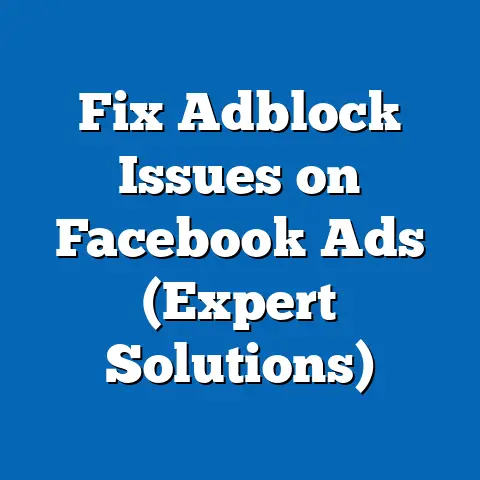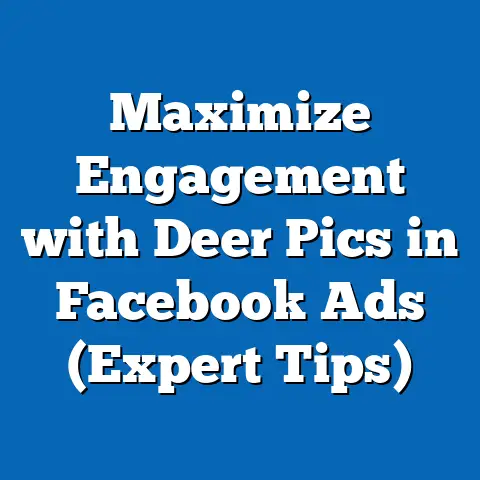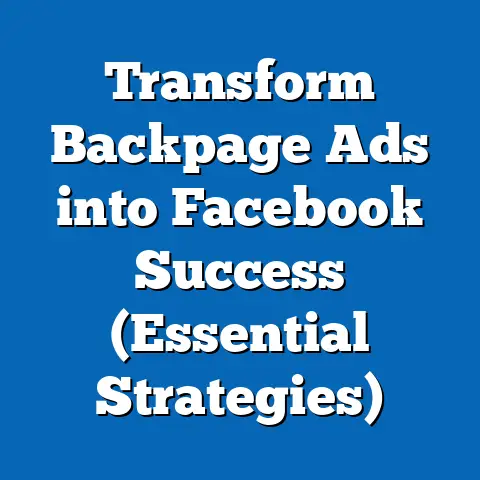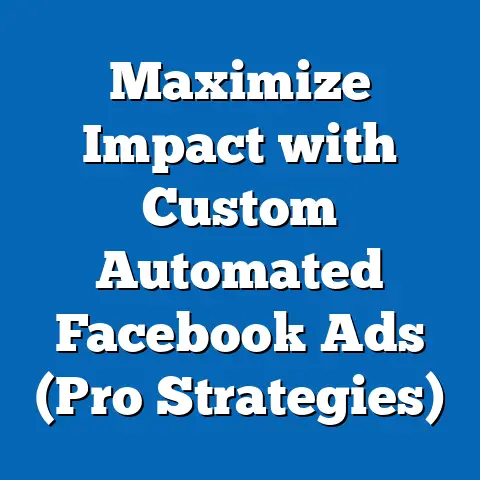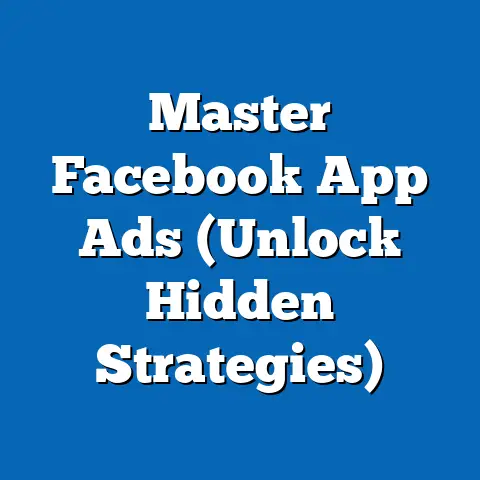Boost Facebook Ads for Maximum Engagement (Expert Tips)
In today’s digital arena, where content bombards us from every angle, businesses find themselves in a constant battle for attention. Social media, especially Facebook with its staggering 2.9 billion active users, is a bustling marketplace. To thrive here, it’s not enough to simply exist; you need to actively engage. Engagement isn’t just a vanity metric; it’s the lifeblood of brand awareness, customer loyalty, and ultimately, sales conversions.
I’ve seen firsthand how a well-crafted Facebook ad can transform a business. I remember working with a local bakery struggling to get noticed. Their products were amazing, but their marketing was falling flat. We revamped their Facebook strategy, focusing on visually appealing ads with engaging questions, and the results were incredible! Their engagement soared, leading to a significant increase in foot traffic and online orders.
However, achieving that level of success requires more than just luck. It demands a deep understanding of Facebook’s advertising ecosystem and a strategic approach to crafting ads that resonate with your target audience. In this article, I’ll share my expert tips and insights on how to boost your Facebook ads for maximum engagement, turning passive viewers into active participants. We’ll delve into everything from understanding the core principles of engagement to leveraging the latest Facebook features and analyzing your results to continuously improve. Let’s dive in!
1: Understanding Engagement in Facebook Ads
Before we jump into specific tactics, let’s lay a solid foundation by defining what engagement truly means within the context of Facebook ads and why it’s so crucial for success.
Defining Engagement
Engagement on Facebook ads goes beyond just seeing your ad. It’s about sparking interaction and fostering a connection with your audience. Think of it as the digital equivalent of a conversation. Key engagement metrics include:
- Likes: A simple indicator of approval or interest.
- Shares: When users find your content valuable enough to share with their own networks, significantly expanding your reach.
- Comments: Direct feedback and questions from your audience, providing valuable insights and opportunities for dialogue.
- Click-Through Rate (CTR): The percentage of people who saw your ad and clicked on the link, indicating the relevance and appeal of your ad to the audience.
- Saves: When users save your ad for later viewing, suggesting they are interested but not ready to take immediate action.
Importance of Engagement
Why does engagement matter so much? Here’s a breakdown of the key benefits:
- Building Relationships with Audiences: Engagement provides a platform for building meaningful relationships with your audience. By responding to comments, answering questions, and participating in conversations, you show your audience that you value their input and are invested in their experience. This personal touch fosters trust and loyalty, turning casual viewers into loyal customers.
- Increasing Visibility Through Organic Reach: Facebook’s algorithm favors content that generates high engagement. When your ads receive likes, shares, and comments, Facebook interprets this as a signal that your content is valuable and relevant to users. As a result, your ads are more likely to be shown to a wider audience, increasing your organic reach and driving even more engagement.
- Fostering Community Around the Brand: High engagement can help you create a community around your brand. When users engage with your ads and interact with each other in the comments section, they form connections and build a sense of belonging. This community can become a powerful asset, providing valuable feedback, advocating for your brand, and driving word-of-mouth marketing.
I remember one campaign where we focused heavily on community building. We ran a contest asking users to share their favorite ways to use the client’s product. The response was overwhelming! People were sharing creative ideas, helping each other troubleshoot problems, and generally building a strong sense of community around the brand. This not only boosted engagement but also provided invaluable insights into how customers were using the product.
Current Trends
Understanding current trends in consumer behavior on Facebook is crucial for crafting ads that resonate with your audience. Here are a few key trends to keep in mind:
- Video is King: Video content continues to dominate social media. Short, engaging videos that capture attention quickly are particularly effective.
- Authenticity Matters: Users are increasingly skeptical of overly polished or salesy ads. Authenticity and transparency are key to building trust and driving engagement.
- Mobile-First Approach: The majority of Facebook users access the platform via mobile devices. Ensure your ads are optimized for mobile viewing, with clear visuals and concise copy.
- Interactive Content: Polls, quizzes, and other interactive ad formats are gaining popularity as they invite user participation and enhance engagement.
Key Takeaway: Engagement is more than just a metric; it’s the foundation of a successful Facebook advertising strategy. By understanding what engagement means, why it matters, and current trends in consumer behavior, you can create ads that resonate with your audience and drive meaningful results.
Next Step: Take some time to analyze your past Facebook ad campaigns. Which ads generated the most engagement? What were the common themes or elements that resonated with your audience? Use these insights to inform your future ad strategies.
2: Crafting Irresistible Content
Now that we understand the importance of engagement, let’s delve into the art of crafting irresistible content that captivates your audience and compels them to interact with your ads.
Know Your Audience
Before you start creating ads, it’s essential to understand who you’re trying to reach. This involves conducting thorough audience research to identify your target demographics and understand their preferences. Here are some methods for doing so:
- Facebook Audience Insights: This tool provides valuable data about your existing audience, including their demographics, interests, behaviors, and purchase habits.
- Surveys and Polls: Conduct surveys and polls to gather direct feedback from your target audience. Ask them about their interests, preferences, pain points, and what type of content they find most engaging.
- Competitor Analysis: Analyze your competitors’ Facebook pages to see what type of content resonates with their audience. Pay attention to the comments and shares to identify what topics and formats are most popular.
- Customer Interviews: Conduct interviews with your existing customers to gain a deeper understanding of their needs, motivations, and pain points.
Compelling Visuals
Visuals play a crucial role in capturing attention and driving engagement on Facebook ads. Here’s a breakdown of different types of visuals and best practices for creating eye-catching content:
- Images: Use high-quality, visually appealing images that are relevant to your ad message. Avoid using stock photos that look generic or staged. Instead, opt for authentic images that showcase your brand’s personality and values.
- Videos: Video content is highly engaging and can be used to tell a story, demonstrate a product, or share valuable information. Keep your videos short and concise, focusing on capturing attention within the first few seconds.
- Carousels: Carousel ads allow you to showcase multiple images or videos in a single ad unit. This format is ideal for showcasing a range of products, highlighting different features, or telling a story in a sequential manner.
When creating visuals, keep the following best practices in mind:
- Use High-Quality Images and Videos: Avoid using blurry or pixelated images. Invest in professional photography or videography to ensure your visuals are top-notch.
- Optimize for Mobile Viewing: Most Facebook users access the platform via mobile devices. Ensure your visuals are optimized for mobile viewing, with clear text and easy-to-see details.
- Use Bright Colors and Contrasting Elements: Bright colors and contrasting elements can help your visuals stand out from the crowd and capture attention.
- Include a Clear Call-to-Action: Make it clear what you want viewers to do after seeing your ad. Include a compelling call-to-action that encourages them to click, learn more, or make a purchase.
I once worked with a client who was hesitant to invest in professional photography. They thought their existing images were “good enough.” However, after conducting A/B testing with professionally shot images, the difference in engagement was undeniable. The professionally shot images generated significantly more clicks and conversions, proving the value of investing in high-quality visuals.
Copywriting Secrets
Compelling ad copy is essential for captivating your audience and prompting them to take action. Here are some tips for writing effective ad copy:
- Start with a Strong Hook: Your hook is the first sentence or two of your ad copy. It should grab the reader’s attention and make them want to learn more. Use a question, a surprising statistic, or a bold statement to pique their interest.
- Highlight the Benefits: Focus on the benefits your product or service offers to the customer, rather than just listing its features. Explain how it will solve their problems, improve their lives, or make them feel better.
- Use Clear and Concise Language: Avoid using jargon or technical terms that your audience may not understand. Use clear and concise language that is easy to read and understand.
- Create a Sense of Urgency: Encourage viewers to take action now by creating a sense of urgency. Use phrases like “limited time offer,” “while supplies last,” or “don’t miss out.”
- Include a Clear Call-to-Action: Tell viewers exactly what you want them to do. Use a strong call-to-action that is clear, concise, and actionable. Examples include “Shop Now,” “Learn More,” “Sign Up Today,” or “Get a Free Quote.”
Key Takeaway: Irresistible content is the foundation of high-engagement Facebook ads. By understanding your audience, creating compelling visuals, and writing captivating ad copy, you can create ads that resonate with your target audience and drive meaningful results.
Next Step: Review your existing Facebook ads. Are your visuals high-quality and engaging? Is your ad copy clear, concise, and benefit-driven? Make any necessary adjustments to improve the overall appeal of your ads.
3: Leveraging Facebook’s Features for Engagement
Facebook offers a wide range of features and tools that can help you boost engagement on your ads. Let’s explore some of the most effective options.
Ad Formats
Choosing the right ad format is crucial for maximizing engagement. Here’s a breakdown of some of the most popular options:
- Image Ads: These are the simplest type of ad, featuring a single image and accompanying text. They are ideal for showcasing a product, promoting an event, or driving traffic to your website.
- Video Ads: Video ads are highly engaging and can be used to tell a story, demonstrate a product, or share valuable information. They are particularly effective for capturing attention and driving brand awareness.
- Carousel Ads: Carousel ads allow you to showcase multiple images or videos in a single ad unit. This format is ideal for showcasing a range of products, highlighting different features, or telling a story in a sequential manner.
- Collection Ads: Collection ads are designed for e-commerce businesses. They feature a hero image or video, followed by a grid of related products. This format is ideal for showcasing your product catalog and driving sales.
- Instant Experience Ads: Instant Experience ads (formerly known as Canvas ads) are full-screen, mobile-optimized ads that provide an immersive and interactive experience. They are ideal for telling a story, showcasing a product in detail, or driving app installs.
The best ad format for you will depend on your specific goals and target audience. Consider what type of content resonates best with your audience and choose the format that is most likely to capture their attention and drive engagement.
Targeting Options
Facebook’s advanced targeting options allow you to reach specific demographics, interests, and behaviors, ensuring your ads are shown to the people who are most likely to be interested in your products or services. Here are some of the most effective targeting options:
- Custom Audiences: Custom Audiences allow you to target people who have already interacted with your business, such as website visitors, email subscribers, or app users. This is a highly effective way to re-engage your existing audience and drive conversions.
- Lookalike Audiences: Lookalike Audiences allow you to target people who are similar to your existing customers. This is a great way to expand your reach and find new customers who are likely to be interested in your products or services.
- Interest Targeting: Interest Targeting allows you to target people based on their interests, hobbies, and passions. This is a great way to reach a broad audience with specific interests that align with your brand.
- Behavior Targeting: Behavior Targeting allows you to target people based on their online behavior, such as their purchase history, travel habits, or device usage. This is a highly targeted way to reach people who are likely to be interested in your products or services.
I’ve found that combining different targeting options can be particularly effective. For example, you could create a Custom Audience of website visitors and then create a Lookalike Audience based on that Custom Audience. This allows you to reach people who are similar to your existing website visitors, increasing the likelihood that they will be interested in your products or services.
A/B Testing
A/B testing, also known as split testing, is a crucial process for optimizing your ad performance. It involves creating two or more versions of an ad and then testing them against each other to see which performs best. Here’s a step-by-step guide on how to conduct effective A/B tests:
- Identify a Variable to Test: Choose one element of your ad to test, such as the headline, image, call-to-action, or targeting option.
- Create Multiple Versions of the Ad: Create two or more versions of the ad, each with a different variation of the variable you are testing.
- Set Up Your A/B Test: Use Facebook’s A/B testing tool to set up your test. Specify the variable you are testing, the different variations, and the duration of the test.
- Monitor the Results: Monitor the results of your A/B test closely. Pay attention to key metrics such as click-through rate, conversion rate, and cost per acquisition.
- Implement the Winning Version: Once the A/B test is complete, implement the winning version of the ad.
Key Takeaway: Facebook offers a wealth of features and tools that can help you boost engagement on your ads. By choosing the right ad format, leveraging advanced targeting options, and conducting A/B tests, you can optimize your ads for maximum performance.
Next Step: Experiment with different ad formats, targeting options, and A/B testing strategies to see what works best for your business. Continuously monitor your results and make adjustments as needed to improve your ad performance.
4: Timing and Frequency
The timing and frequency of your ads can significantly impact their engagement levels. Let’s explore how to optimize these factors for maximum impact.
Optimal Posting Times
Knowing when your target audience is most active on Facebook is crucial for maximizing engagement. Posting ads when your audience is online increases the likelihood that they will see your ads and interact with them. Here are some factors to consider when determining the best times to post:
- Audience Demographics: Different demographics have different online habits. For example, younger audiences may be more active in the evenings, while older audiences may be more active during the day.
- Industry Studies: Numerous industry studies have analyzed the best times to post on Facebook. These studies can provide valuable insights into general trends, but it’s important to remember that your specific audience may have different preferences.
- Facebook Insights: Facebook Insights provides data about when your audience is most active on Facebook. Use this data to identify the best times to post your ads.
While general guidelines exist, the most effective approach is to test different posting times and track your results. Pay attention to when your ads generate the most engagement and adjust your schedule accordingly.
Ad Frequency
Ad frequency refers to the number of times a user sees your ad. While it’s important to ensure your ads are seen by your target audience, showing them the same ad too many times can lead to ad fatigue and decreased engagement.
Here are some strategies for managing ad frequency effectively:
- Monitor Frequency Metrics: Facebook provides metrics that track the frequency of your ads. Monitor these metrics closely to identify when your ads are being shown too often.
- Rotate Your Ads: Rotate your ads regularly to avoid showing the same ad to the same users too many times. Create multiple versions of your ads with different visuals, headlines, and calls-to-action.
- Use Frequency Capping: Facebook allows you to set frequency caps, which limit the number of times a user sees your ad within a specific timeframe. Use frequency capping to prevent ad fatigue and ensure your ads remain fresh and engaging.
I’ve seen firsthand how ad fatigue can negatively impact engagement. In one campaign, we initially saw high engagement rates, but as the frequency increased, the engagement started to decline. By implementing frequency capping and rotating our ads, we were able to reverse the trend and maintain high engagement levels.
Key Takeaway: Timing and frequency are crucial factors in maximizing engagement on your Facebook ads. By posting your ads when your audience is most active and managing ad frequency effectively, you can ensure your ads are seen by the right people at the right time, without causing ad fatigue.
Next Step: Analyze your Facebook Insights data to identify the best times to post your ads. Implement frequency capping and rotate your ads regularly to prevent ad fatigue. Continuously monitor your results and make adjustments as needed to optimize your timing and frequency strategy.
5: Engaging with Your Audience
Engagement isn’t just about getting people to see your ads; it’s about fostering a conversation and building a relationship with your audience. Here’s how to actively engage with users who interact with your ads.
Responding to Comments
Responding to comments on your ads is a crucial part of building a community and fostering engagement. Here are some strategies for providing timely and authentic responses:
- Monitor Your Comments Regularly: Check your ad comments frequently to ensure you are responding to inquiries and addressing concerns in a timely manner.
- Be Authentic and Personal: Avoid using generic or canned responses. Instead, respond to each comment in a personal and authentic way.
- Answer Questions Thoroughly: If a user asks a question, provide a thorough and informative answer.
- Address Concerns Empathetically: If a user expresses a concern or complaint, acknowledge their feelings and offer a solution.
- Encourage Further Interaction: End your responses with a question or invitation to encourage further interaction.
Remember, every comment is an opportunity to connect with your audience and build a stronger relationship.
Utilizing User-Generated Content (UGC)
User-generated content (UGC) is any content that is created by your customers, such as photos, videos, or reviews. Incorporating UGC into your ad campaigns can add authenticity and credibility to your brand, as well as increase engagement. Here’s how to encourage and incorporate UGC:
- Run Contests and Giveaways: Encourage users to submit their own content by running contests and giveaways. Offer prizes for the best photos, videos, or reviews.
- Feature UGC on Your Page: Showcase UGC on your Facebook page to highlight your customers’ experiences and encourage others to share their own content.
- Use UGC in Your Ads: Incorporate UGC into your ad campaigns to add authenticity and credibility. For example, you could use a customer’s photo or video in your ad, or feature a positive review.
I’ve seen UGC have a massive impact on ad performance. It’s often more relatable and trustworthy than branded content, leading to higher engagement and conversion rates.
Creating Interactive Ads
Interactive ads, such as polls and quizzes, invite user participation and enhance engagement. These ad formats can be a fun and engaging way to capture attention and gather valuable insights from your audience. Here are some examples of interactive ads:
- Poll Ads: Poll ads allow you to ask users a question and provide them with multiple choice answers. This is a great way to gather feedback on your products or services, or to learn more about your audience’s preferences.
- Quiz Ads: Quiz ads allow you to test users’ knowledge or personality. This is a fun and engaging way to capture attention and drive brand awareness.
- Instant Experience Ads: Instant Experience ads can be designed to be interactive, with features such as swipeable carousels, clickable buttons, and embedded videos.
Key Takeaway: Engaging with your audience is essential for building a community and fostering loyalty. By responding to comments, utilizing UGC, and creating interactive ads, you can create a more engaging and rewarding experience for your audience.
Next Step: Start monitoring your ad comments regularly and responding to inquiries and concerns in a timely manner. Explore ways to encourage and incorporate UGC into your ad campaigns. Experiment with interactive ad formats to see how they perform with your audience.
6: Analyzing Engagement Metrics
Analyzing your engagement metrics is crucial for understanding what’s working and what’s not. It allows you to make data-driven adjustments to your strategies and continuously improve your results.
Key Metrics to Track
Here are some of the most important metrics to track when measuring engagement success:
- Click-Through Rate (CTR): The percentage of people who saw your ad and clicked on the link. A high CTR indicates that your ad is relevant and appealing to your audience.
- Engagement Rate: The percentage of people who saw your ad and interacted with it in some way, such as liking, sharing, or commenting. A high engagement rate indicates that your ad is capturing attention and sparking conversation.
- Cost Per Engagement (CPE): The cost you pay for each engagement on your ad. A low CPE indicates that you are getting good value for your advertising spend.
- Conversion Rate: The percentage of people who clicked on your ad and completed a desired action, such as making a purchase or signing up for a newsletter. A high conversion rate indicates that your ad is driving results.
Using Facebook Insights
Facebook Insights provides a wealth of data about your ad performance. Here’s a guide on how to use Facebook Insights to analyze your ad performance:
- Go to Facebook Insights: Access Facebook Insights by clicking on the “Insights” tab on your Facebook page.
- Select Your Time Period: Choose the time period you want to analyze.
- Explore the Data: Explore the various data points available, such as reach, engagement, and conversions.
- Analyze Your Results: Analyze your results to identify trends and patterns. What type of content is performing best? What demographics are most engaged?
- Make Adjustments: Based on your findings, make adjustments to your ad strategies to improve your performance.
Facebook Insights is a powerful tool that can help you understand your audience and optimize your ad campaigns.
Adjusting Strategies Based on Data
The key to maximizing engagement is to continuously analyze your data and adjust your strategies accordingly. Here are some examples of how you can use data to inform your decisions:
- If your CTR is low: Try testing different headlines, visuals, or calls-to-action.
- If your engagement rate is low: Try creating more engaging content, such as videos or interactive ads.
- If your CPE is high: Try refining your targeting options or optimizing your bidding strategy.
- If your conversion rate is low: Try improving your landing page or simplifying the checkout process.
Remember, Facebook advertising is an iterative process. By continuously analyzing your data and making adjustments, you can optimize your campaigns for maximum engagement and results.
Key Takeaway: Analyzing your engagement metrics is essential for understanding what’s working and what’s not. By using Facebook Insights to track your performance and adjusting your strategies based on data, you can continuously improve your results.
Next Step: Set up a system for tracking your key engagement metrics. Regularly review your Facebook Insights data and make adjustments to your strategies as needed.
7: Case Studies and Success Stories
Let’s examine some real-world examples of brands that have successfully boosted engagement through innovative Facebook ad strategies.
Case Study 1: Dollar Shave Club
Dollar Shave Club is a subscription-based razor company that gained viral fame with its humorous and engaging video ads. Their initial video ad, which cost just \$4,500 to produce, generated over 12,000 orders within 48 hours and helped them establish a strong brand identity.
Key Takeaways:
- Humor can be highly effective: Dollar Shave Club’s humorous approach resonated with their target audience and helped them stand out from the competition.
- Authenticity matters: Their video ad was authentic and relatable, which helped them build trust with their audience.
- Focus on the benefits: Their ad clearly highlighted the benefits of their product, such as convenience and affordability.
Case Study 2: Airbnb
Airbnb uses Facebook ads to target travelers who are looking for unique and authentic experiences. They often feature user-generated content in their ads, showcasing the experiences of real travelers who have stayed in Airbnb properties.
Key Takeaways:
- UGC adds credibility: Featuring UGC in their ads adds authenticity and credibility to their brand.
- Target specific interests: Airbnb targets travelers who are interested in specific destinations or activities, ensuring their ads are relevant to their audience.
- Highlight unique experiences: Airbnb focuses on highlighting the unique experiences that travelers can have when staying in their properties.
Case Study 3: Warby Parker
Warby Parker is an online eyewear retailer that uses Facebook ads to drive traffic to their website and encourage customers to try on glasses at home. They often feature visually appealing images of their glasses in their ads, as well as testimonials from satisfied customers.
Key Takeaways:
- Visually appealing images are crucial: Warby Parker’s ads feature high-quality images that showcase their glasses in an attractive way.
- Testimonials build trust: Featuring testimonials from satisfied customers helps build trust and credibility.
- Make it easy to try before you buy: Warby Parker makes it easy for customers to try on glasses at home, which removes a major barrier to purchase.
Lessons Learned:
These case studies highlight several common themes that contribute to successful Facebook ad campaigns:
- Understand your audience: Know who you’re targeting and what resonates with them.
- Create engaging content: Use visuals, humor, and storytelling to capture attention.
- Be authentic: Build trust by being transparent and relatable.
- Focus on the benefits: Highlight the value you offer to your customers.
- Test and optimize: Continuously analyze your results and adjust your strategies.
Key Takeaway: Learning from successful Facebook ad campaigns can provide valuable insights and inspiration for your own strategies.
Next Step: Research successful Facebook ad campaigns in your industry and identify the key elements that contributed to their success. Apply these lessons to your own ad strategies.
Conclusion: The Future of Facebook Ads Engagement
As we look ahead, the landscape of Facebook ads and engagement is poised for significant evolution. Emerging trends, technologies, and shifts in consumer behavior will undoubtedly reshape how businesses connect with their audiences on the platform.
Emerging Trends:
- Augmented Reality (AR): AR is poised to become a major force in Facebook advertising, allowing businesses to create immersive and interactive experiences for their audience. Imagine trying on a virtual pair of glasses or visualizing furniture in your home before making a purchase.
- Personalized Experiences: As Facebook gathers more data about its users, businesses will be able to create increasingly personalized ad experiences. This will involve tailoring ad content, targeting, and even ad formats to individual users’ preferences and behaviors.
- Artificial Intelligence (AI): AI is already playing a significant role in Facebook advertising, and its influence is only set to grow. AI-powered tools can help businesses optimize their ad campaigns, personalize their messaging, and even predict which ads are most likely to generate engagement.
Potential Shifts in Consumer Behavior:
- Increased Demand for Authenticity: Consumers are becoming increasingly skeptical of overly polished or salesy ads. They are looking for authentic and relatable content that resonates with their values and interests.
- Greater Focus on Privacy: As concerns about data privacy continue to grow, consumers are becoming more protective of their personal information. Businesses will need to be transparent about how they are using data and respect users’ privacy preferences.
- Mobile-First Mindset: Mobile devices are now the primary way that most people access Facebook. Businesses will need to prioritize mobile optimization in their ad campaigns, ensuring their ads are visually appealing and easy to interact with on smartphones and tablets.
Key Takeaway: Staying ahead of the curve and adapting to emerging trends is essential for maximizing engagement on Facebook ads.
Next Step: Keep abreast of the latest developments in Facebook advertising and experiment with new technologies and strategies. Continuously monitor your results and adjust your approach as needed to stay ahead of the competition.
By understanding the principles of engagement, crafting irresistible content, leveraging Facebook’s features, optimizing your timing and frequency, engaging with your audience, analyzing your metrics, and learning from successful case studies, you can boost your Facebook ads for maximum engagement and achieve your business goals. Remember, Facebook advertising is an ongoing process. Continuously test, analyze, and refine your strategies to stay ahead of the curve and maximize your results. Good luck!

